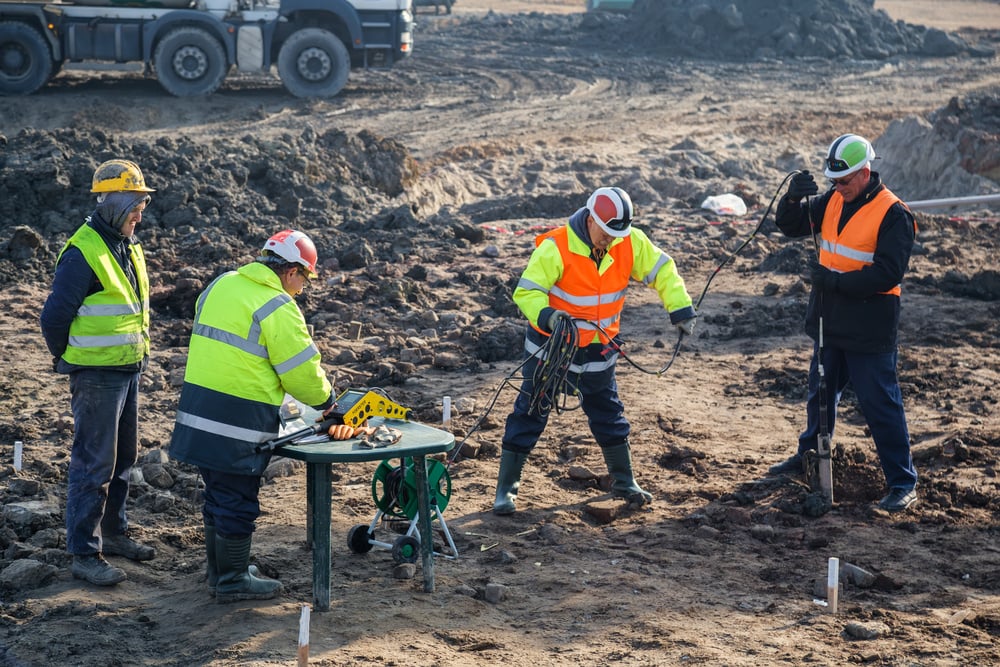The Greatest Guide To Geotechnical Engineering For Construction Projects
The Greatest Guide To Geotechnical Engineering For Construction Projects
Blog Article
Not known Factual Statements About Geotechnical Engineering For Construction Projects
Table of ContentsGeotechnical Engineering For Construction Projects Can Be Fun For AnyoneOur Geotechnical Engineering For Construction Projects Statements8 Simple Techniques For Geotechnical Engineering For Construction ProjectsGeotechnical Engineering For Construction Projects Things To Know Before You Get ThisGeotechnical Engineering For Construction Projects Things To Know Before You Get ThisSome Known Details About Geotechnical Engineering For Construction Projects
The function of geotechnical design substantially handles recognizing the features of dirt and rock, which may differ substantially by their density, dampness content etc. These functions need to be checked out by geotechnical engineers to anticipate their movements under various conditions. The safety and security in addition to security of frameworks are affected by dirt problems, making this evaluation essential.A geotechnical designer will take a look at soil to identify the bearing ability of the earth and advise correct structure types, such as superficial foundations, deep structures like stacks, or specialized solutions like drifting structures for soft soils. Recognizing the features and activities of soil and rock, in addition to how they connect with buildings that have actually been put up on or within them, is one of the primary explanations for why geotechnical design is essential.
Along with architectural preparation and construction, geotechnical engineering is likewise vital to the repair and upkeep of pre-existing structures. Age-related destruction or extra problems could affect a framework's security and effectiveness. Environmental management is achieved through geotechnical design. Experience in air, water, and dirt high quality upkeep is used by geotechnical designers to minimize the negative results of tasks.
To sum up, geotechnical engineering is a crucial technique that preserves the resilience and integrity of civil infrastructure. Geotechnical designers add to making building tasks efficient all over the world by comprehending the behavior of planet products and applying appropriate preparation techniques.
Our Geotechnical Engineering For Construction Projects Ideas
The foundational stability of any project is vital. Geotechnical design plays a vital function in guaranteeing that frameworks are built on solid ground, actually and figuratively. By analyzing dirt, rock, and subsurface problems, geotechnical designers provide vital understandings that assist in the layout, construction, and upkeep of buildings and facilities.

Geotechnical Engineering For Construction Projects Fundamentals Explained
Lab screening: Identifying the residential or commercial properties of dirt and rock. Field screening: Performing examinations on-site to evaluate conditions. Evaluation and style: Making use of data to create foundations, preserving wall surfaces, tunnels, and other frameworks. A number of high-profile building tasks have efficiently used geotechnical engineering to ensure their stability and safety and security. For instance:: The world's tallest structure required a deep understanding of the underlying geology.

As a leader in geotechnical design, BECC Inc. is devoted to supplying cutting-edge and efficient services that fulfill the greatest criteria of top quality and security., a mechanical designer and rock hound.
Geotechnical Engineering For Construction Projects for Dummies
Terzaghi likewise developed the structure for concepts of bearing capability of structures, and the concept for prediction of the price of negotiation of clay layers as a result of loan consolidation. Afterwards, Maurice Biot completely established the three-dimensional dirt consolidation theory, expanding the one-dimensional model formerly created by Terzaghi to extra basic theories and introducing the set of standard formulas of Poroelasticity.
Geotechnical engineers check out and identify the residential properties of i was reading this subsurface conditions Resources and materials. They also design corresponding earthworks and preserving frameworks, tunnels, and structure structures, and may manage and evaluate sites, which might even more entail website monitoring along with the risk analysis and reduction of all-natural hazards - Geotechnical Engineering for Construction Projects. Geotechnical engineers and engineering rock hounds carry out geotechnical examinations to acquire details on the physical properties of dirt and rock underlying and adjacent to a site to design earthworks and foundations for proposed structures and for the fixing of distress to earthworks and structures triggered by subsurface problems.
The smart Trick of Geotechnical Engineering For Construction Projects That Nobody is Talking About
, which uses a thick-walled split spoon sampler, is the most usual way to accumulate disturbed examples.

If the user interface between the mass and the base of an incline has an intricate geometry, slope security evaluation is tough and numerical solution techniques are called for. Generally, the user interface's exact geometry is unknown, and a streamlined interface geometry is assumed. Finite inclines call for three-dimensional versions to be analyzed, so most inclines are my sources examined assuming that they are infinitely broad and can be represented by two-dimensional designs.
Excitement About Geotechnical Engineering For Construction Projects
Developing the design based on a functioning theory of actions prepared for under the most likely conditions. Option of amounts to be observed as building and construction earnings and calculating their prepared for values based on the functioning theory under the most negative problems.
Dimension of quantities and evaluation of actual conditions. It is improper for projects whose design can not be changed throughout building.
Report this page